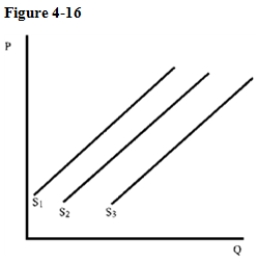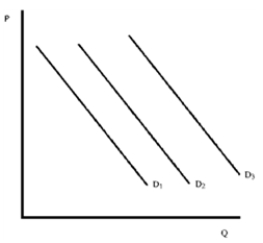A) increase.
B) decrease.
C) not change.
D) Uncertain-economic theory has no answer to this question.
Correct Answer

verified
Correct Answer
verified
Multiple Choice
Equilibrium in a market is
A) a situation in which there are no inherent forces that produce change.
B) the natural state of affairs in the market.
C) the actual price and quantity that will exist in a market.
D) the best price and quantity that can exist in a market.
E) All of these responses are correct.
Correct Answer

verified
Correct Answer
verified
Multiple Choice
 -In Figure 4-16, an increase in the number of producers will shift supply from
-In Figure 4-16, an increase in the number of producers will shift supply from
A) S1 to S2.
B) S2 to S1.
C) S3 to S2.
D) S3 to S1.
Correct Answer

verified
Correct Answer
verified
True/False
The laws of supply and demand did not apply to elephant tusks.
Correct Answer

verified
Correct Answer
verified
Multiple Choice
Are markets always in equilibrium?
A) Yes, they are always at the equilibrium point, or very close to it.
B) Yes, because few things tend to alter supply and demand.
C) No, but if there is no interference, they tend to move toward equilibrium.
D) No, they never "settle down" into a stable price and quantity.
E) Uncertain, economic theory has no answer to this question.
Correct Answer

verified
Correct Answer
verified
Multiple Choice
The major drawback of a price ceiling is
A) it causes a surplus.
B) government regulations of this kind are difficult to enforce.
C) it causes a shortage.
D) there is no drawback.
Correct Answer

verified
Correct Answer
verified
True/False
As more firms are attracted to an industry, the supply curve can be expected to shift to the right.
Correct Answer

verified
Correct Answer
verified
True/False
Even though prices may change frequently, they can be expected to gravitate toward equilibrium.
Correct Answer

verified
Correct Answer
verified
Multiple Choice
 -Assume that Figure 4-16 shows the supply of steak.An increase in the price of cattle feed will change the supply from
-Assume that Figure 4-16 shows the supply of steak.An increase in the price of cattle feed will change the supply from
A) S1 to S2.
B) S2 to S1.
C) S2 to S3.
D) S1 to S3.
Correct Answer

verified
Correct Answer
verified
True/False
At equilibrium, the market will clear, with no surpluses or shortages occurring.
Correct Answer

verified
Correct Answer
verified
Multiple Choice
The supply curve of books (which are produced using paper made from trees) will shift to the left in response to
A) a decline in college tuition.
B) an increase in home building.
C) an increase in the supply of lumberjacks.
D) an end to government regulations that limit timber harvesting in national forests.
Correct Answer

verified
Correct Answer
verified
Multiple Choice
In the 1990s, Congress considered an agriculture bill that would gradually reduce price supports for many agricultural products.If the bill were to be approved, what would most likely happen to the number of families employed in agriculture?
A) It would decrease, because agricultural prices would fall.
B) It would decrease, because agricultural prices would rise.
C) It would increase, because agricultural prices would fall.
D) It would increase, because agricultural prices would rise.
Correct Answer

verified
Correct Answer
verified
Multiple Choice
When there is an increase in demand,
A) the demand curve shifts to the right of the original demand curve.
B) the demand curve rotates clockwise.
C) the demand curve shifts to the left of the original demand curve.
D) the demand curve rotates counterclockwise.
E) a lower price has increased the amount of the good that consumers will buy.
Correct Answer

verified
Correct Answer
verified
True/False
Sugar price supports ensure an abundance of sugar, and hence reasonable prices for consumers.
Correct Answer

verified
Correct Answer
verified
Multiple Choice
Figure 4-4  -Assume that Figure 4-4 shows demand for soda.An increase in the price of bottled water will change demand from
-Assume that Figure 4-4 shows demand for soda.An increase in the price of bottled water will change demand from
A) D1 to D2.
B) D2 to D1.
C) D3 to D2.
D) D3 to D1.
Correct Answer

verified
Correct Answer
verified
Multiple Choice
Figure 4-4  -Assume that Figure 4-4 shows demand for skirt steak, which is used to make fajitas.A decrease in the price of tortillas will change demand from
-Assume that Figure 4-4 shows demand for skirt steak, which is used to make fajitas.A decrease in the price of tortillas will change demand from
A) D1 to D2.
B) D2 to D1
C) D3 to D2.
D) D3 to D1.
Correct Answer

verified
Correct Answer
verified
Multiple Choice
The demand curve shows graphically how much consumers
A) purchased at different prices over time.
B) purchase at different prices in different periods.
C) are willing and able to buy over a range of prices during a particular period.
D) are willing and able to buy over a range of prices in over time.
Correct Answer

verified
Correct Answer
verified
Multiple Choice
When a demand schedule is drawn as a graph,
A) price is measured on the vertical axis.
B) quantity is measured on the horizontal axis.
C) the resulting curve has a negative slope.
D) the other variables (besides price and quantity) are held constant.
E) All of these responses are correct.
Correct Answer

verified
Correct Answer
verified
Multiple Choice
A key assumption made when a supply schedule is constructed is that
A) the only factors that matter in determining supply are price and quantity.
B) firms only want to sell a certain amount of a product.
C) supply is too important to be left to the marketplace.
D) only price and quantity vary, all other determinants of supply are held constant.
E) demand has a positive slope.
Correct Answer

verified
Correct Answer
verified
True/False
Any event that causes either the demand curve or the supply curve to shift will also change the equilibrium price and quantity.
Correct Answer

verified
Correct Answer
verified
Showing 41 - 60 of 297
Related Exams